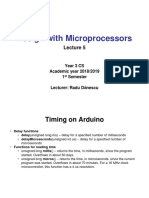0 ratings0% found this document useful (0 votes)
8 viewsProgramming-Arduino (1) - Pages-146
Uploaded by
axl1994Copyright
© © All Rights Reserved
Available Formats
Download as PDF, TXT or read online on Scribd
0 ratings0% found this document useful (0 votes)
8 viewsProgramming-Arduino (1) - Pages-146
Uploaded by
axl1994Copyright
© © All Rights Reserved
Available Formats
Download as PDF, TXT or read online on Scribd
You are on page 1/ 1
The following is the key line in the setup function of this sketch:
attachInterrupt(0, goFast, FALLING);
The first argument specifies which of the two interrupts you want to use. Rather
confusingly, a 0 here means you are using pin 2, while a 1 means you are using
pin 3.
The next argument is the name of the function that is to be called when there
is an interrupt, and the final argument is a constant that will be one of
CHANGE, RISING , or FALLING . Figure 7-4 summarizes these options.
Figure 7.4 Types of interrupt signals .
If the interrupt mode is CHANGE , then either a RISING from 0 to 1 or a
FALLING from 1 to 0 will both trigger an interrupt.
You can disable interrupts using the function noInterrupts . This stops all
interrupts from both interrupt channels. You can resume using interrupts again
by calling the function interrupts .
Different Arduino boards have different interrupt names for different pins so
if you are not using an Arduino Uno, check the documentation for your board on
http://www.arduino.cc .
Conclusion
In this chapter, you have looked at some of the handy features that the Arduino
standard library provides. These features will save you some programming
effort, and if there is one thing that a good programmer likes, it is being able to
You might also like
- Using Interrupts On Arduino - Technical ArticlesNo ratings yetUsing Interrupts On Arduino - Technical Articles2 pages
- Arduino Interrupts Tutorial - The Robotics Back-EndNo ratings yetArduino Interrupts Tutorial - The Robotics Back-End19 pages
- Arduino: Attachinterrupt (Interrupt, Function, Mode)No ratings yetArduino: Attachinterrupt (Interrupt, Function, Mode)2 pages
- Exercises 4 - Hardware Timers and InterruptsNo ratings yetExercises 4 - Hardware Timers and Interrupts8 pages
- Electronics & Robotics Club: Introductory Lecture ON ArduinoNo ratings yetElectronics & Robotics Club: Introductory Lecture ON Arduino60 pages
- Gammon Forum - Electronics - Microprocessors - InterruptsNo ratings yetGammon Forum - Electronics - Microprocessors - Interrupts27 pages
- 8051 Tutorial: Interrupts: JNB Tf0, Skip - Toggle CPL P3.0 CLR Tf0 Skip - Toggle: ..No ratings yet8051 Tutorial: Interrupts: JNB Tf0, Skip - Toggle CPL P3.0 CLR Tf0 Skip - Toggle: ..8 pages
- Embedded Programming and Robotics: Lesson 11 Arduino Interrupts100% (1)Embedded Programming and Robotics: Lesson 11 Arduino Interrupts8 pages
- Section 13 - Understand The Interrupts On Arduino UNONo ratings yetSection 13 - Understand The Interrupts On Arduino UNO8 pages
- Embedded Systems: Assist. Prof. Rassim Suliyev - SDU 2018 Week 4No ratings yetEmbedded Systems: Assist. Prof. Rassim Suliyev - SDU 2018 Week 430 pages
- Arduino Sketches _ Arduino DocumentationNo ratings yetArduino Sketches _ Arduino Documentation3 pages
- Delay 1.0K Millis 2.3K Micros 1.0K Delaymicroseconds 359 Analogwrite 274 Tone 1.4K Notone 76 Servo Library 1.6K100% (1)Delay 1.0K Millis 2.3K Micros 1.0K Delaymicroseconds 359 Analogwrite 274 Tone 1.4K Notone 76 Servo Library 1.6K11 pages
- Design With Microprocessors: Year 3 CS Academic Year 2018/2019 1 Semester Lecturer: Radu D ĂnescuNo ratings yetDesign With Microprocessors: Year 3 CS Academic Year 2018/2019 1 Semester Lecturer: Radu D Ănescu23 pages
- Arduino _ Architecture, Programming and ApplicationNo ratings yetArduino _ Architecture, Programming and Application64 pages

































































